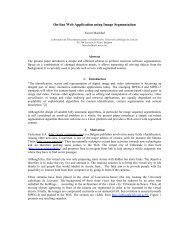motion estimation and compensation for very low bitrate video coding
motion estimation and compensation for very low bitrate video coding
motion estimation and compensation for very low bitrate video coding
You also want an ePaper? Increase the reach of your titles
YUMPU automatically turns print PDFs into web optimized ePapers that Google loves.
34 Chapter 1. Digital Video Coding at Very-Low BitRate<br />
This PPD considers that Multimedia is the convergent point of three<br />
industries, i.e. computer, telecommunications <strong>and</strong> TV/ lm industries.<br />
Although focusing at rst on all the <strong>very</strong>-<strong>low</strong> <strong>bitrate</strong> applications [103],<br />
MPEG-4 has decided to extend its scope so as to be a much more<br />
open <strong>and</strong> evolutive system: exibility <strong>and</strong> extensibility are its driving<br />
<strong>for</strong>ces.<br />
The fol<strong>low</strong>ing sections highlight [57] the key points of MPEG-4 motivation(s)<br />
<strong>and</strong> principle(s). More details may be found in the Image<br />
Communication Special Issue [104] that explores the various aspects of<br />
the future st<strong>and</strong>ard on a <strong>video</strong> point of view.<br />
1.4.3.1 Developments to Be Supported<br />
In addition to the increasing need <strong>for</strong> audio-visual communications at<br />
<strong>very</strong>-<strong>low</strong> <strong>bitrate</strong> [103], some new trends concerning the use of audiovisual<br />
in<strong>for</strong>mation have to be taken into account. These are mainly:<br />
The way images are produced. Computer-generated images are<br />
being <strong>very</strong> commonly used. MPEG-4 addresses both \Synthetic<br />
& Natural Hybrid Coding" (SNHC [26]).<br />
The waymultimedia content isdelivered. VLBR is needed across<br />
\Global System <strong>for</strong> Mobile communications" (GSM) networks, but<br />
the same content could also been transmitted across ADSL (Asymmetric<br />
Digital Subscriber Loop) or ATM (Asynchronous Transfer<br />
Mode) nets, at a rate of several Megabits per second. Such a large<br />
range of <strong>bitrate</strong>s requires scalability. Moreover, a scalable description<br />
of the in<strong>for</strong>mation will enable the decoder to adapt itself<br />
to the processing power of the machine.<br />
The consumption of multimedia is rapidly evolving as it is taking<br />
more <strong>and</strong> more place in the way people communicate. The main<br />
changes in consumer habits are the need <strong>for</strong> interactive supports,<br />
possibilities to re-use the in<strong>for</strong>mation <strong>and</strong> software implementations.<br />
1.4.3.2 A New Challenge <strong>for</strong> the Representation of Audio-<br />
Visual In<strong>for</strong>mation<br />
In order to ll all these needs, MPEG-4 represents an audio-visual scene<br />
in a new way [100]: rather than considering a frame-based <strong>video</strong>, it





